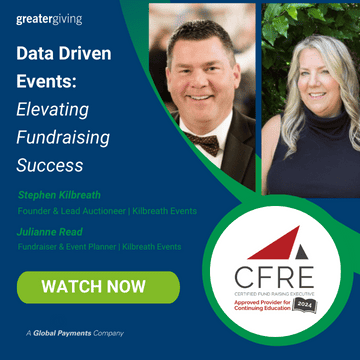
Evaluating Your 2024 Fundraising Events: What Worked and What Didn’t?
As 2024 wraps up, now is the perfect time for evaluating fundraising events. By analyzing what worked and what didn’t, you can refine your strategies for 2025 to maximize engagement, revenue, and donor retention. Whether your events included auctions, galas, or virtual campaigns, understanding key metrics and takeaways will set you up for even greater success next year.
In this guide, we’ll break down how to assess your events effectively, what KPIs (Key Performance Indicators) matter most, and how to apply your insights moving forward.
Why Event Evaluation Matters for Fundraising Success
Post-event evaluations are more than just number crunching—they reveal opportunities to enhance donor experiences, streamline event operations, and optimize ROI. Here’s why you should prioritize a thorough review:
- Measure Performance – Track goals like attendance, revenue, and donor engagement.
- Identify Opportunities – Find areas for improvement and implement best practices.
- Refine Strategies – Apply data to optimize your fundraising campaigns for 2025.
Key Metrics to Evaluate Your Fundraising Events
When assessing your events, focus on measurable outcomes that align with your goals. Focusing on these metrics will help you quickly assess success and identify areas to improve for future events.
Attendance and Engagement
Total Number of Attendees vs. Goal
Compare your actual attendance with your goal to measure event success. Evaluate your venue capacity to see if you have room to grow or if you need a different venue.
Attendee Engagement
Track metrics like number of auction bids, donations, social media shares, and post-event survey responses to gauge participation and event impact.
Return Rates
A high return rate shows your event delivers value and builds loyalty. Use this data to improve retention strategies and build relationships.
Fundraising Revenue
Tracking these metrics gives you a clearer view of your events financial performance and areas to optimize for greater growth.
Gross Revenue vs. Net Profit
Start with the big picture: total funds raised (gross profit) and subtract expenses to determine your net profit. This reveals your events true financial impact.
Sponsorship Contributions and ROI
Measure the value of sponsorships and their return on investment. Did sponsor contributions cover costs, enhance the event, or drive additional fundraising? Strong sponsorship ROI can make or break your events success. This will also help you identify sponsorship levels that may need to be adjusted in the future.
Average Donation Per Attendee
Divide the total revenue by the number of attendees to find the average donation per person. This metric helps you understand donor behavior and set future goals for increasing per-attendee contributions.
Donor Retention and Acquisition
By measuring these metrics you can assess how well your event balances attracting new attendees with retaining existing ones.
New Donor Acquisition Rate
This measures the percentage of first-time donors at your event. To calculate, divide the number of new attendees by the total number of attendees. A high acquisition rate shows your event successfully attracted fresh support, expanding your donor case. Track this through your event registration data based on previous attendance.
Repeat Donor Participation
Repeat attendees indicate loyalty and long-term event impact. Compare donor lists from previous years events to identify repeat participants. High retention rates mean your event is building trust and fostering lasting relationships that can possibly grow into major gifts.
Event Expenses and ROI
Monitoring event costs and ROI ensures your fundraising events are both impactful and financially sustainable.
Event Costs
Track all expenses-venue, catering, photography, AV, marketing, and supplies. Tracking expenses will help you understand the total cost of hosting your event. Keeping a detailed breakdown helps identify areas to cut costs and improve efficiency for 2025 fundraising events.
Cost-to-donor ratio: How much did you spend to raise funds?
Divide total event expenses by the amount raised to calculate the cost-to-donor ratio. For example, if you spent $40,000 and raised $160,000, your ratio is 25%, meaning 25 cents were spent for every dollar raised. A lower ratio indicates higher fundraising efficiency.
Identifying What Worked and What Didn’t
After reviewing metrics, categorize your findings into successes, challenges, and actionable insights:
What Worked
Identify high-performing fundraising tactics like silent auctions or paddle raises. Include positive donor feedback and strong engagement when you’re evaluating what went well.
What Didn’t Work
Look for activities that had a low ROI on certain activities or expenses. Underwhelming attendance or new donor acquisition are red flags that these activities need to be revamped or sunset.
What to Improve
Look for ways you can improve with your people and processes. Using tools like Greater Giving can help you manage your event from start to finish with actionable data at your fingertips to make better decisions as you begin planning your 2025 fundraising calendar.
Turning Insights Into Action for 2025
Use your evaluation findings to refine your 2025 event strategy:
- Set SMART Goals: Specific, Measurable, Achievable, Relevant, and Timely goals.
- Invest in Technology: Use event management tools to simplify planning and track performance.
- Engage Donors Year-Round: Foster relationships through email, social media, and targeted campaigns.
Evaluating your 2024 fundraising events provides invaluable insights to shape your future strategies. By focusing on key metrics, celebrating wins, and addressing challenges, you can create more impactful and efficient fundraising events in 2025.
Looking for more expert tips? Subscribe to our blog for year-round insights on fundraising!
